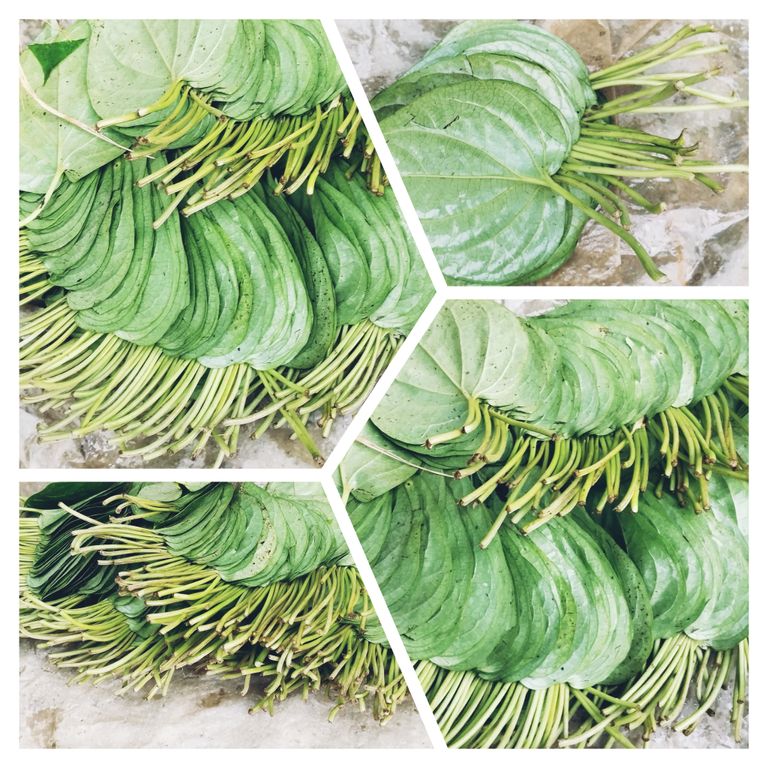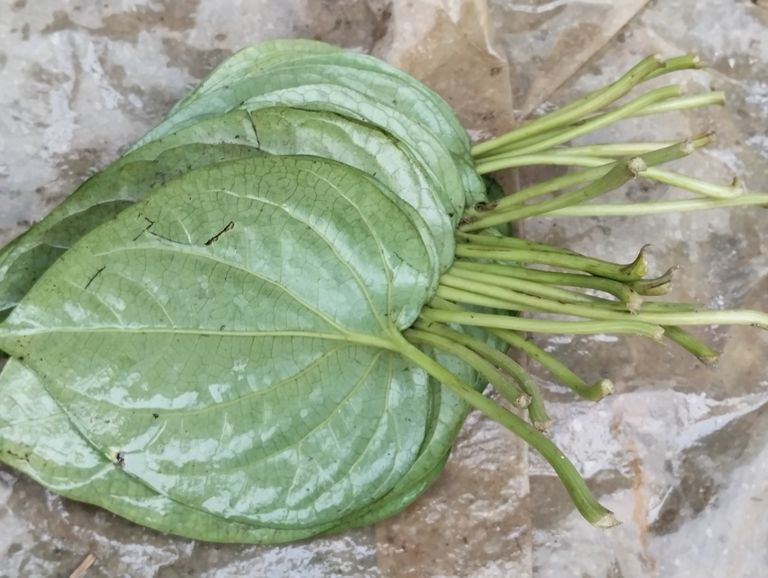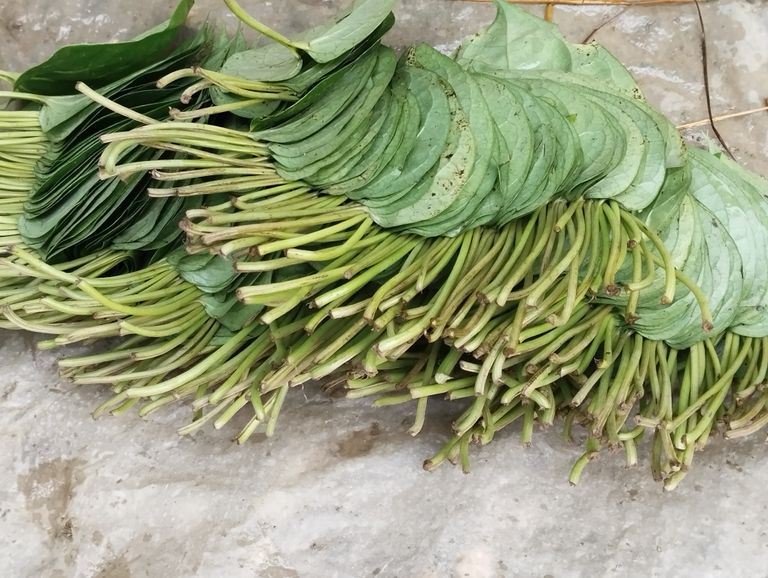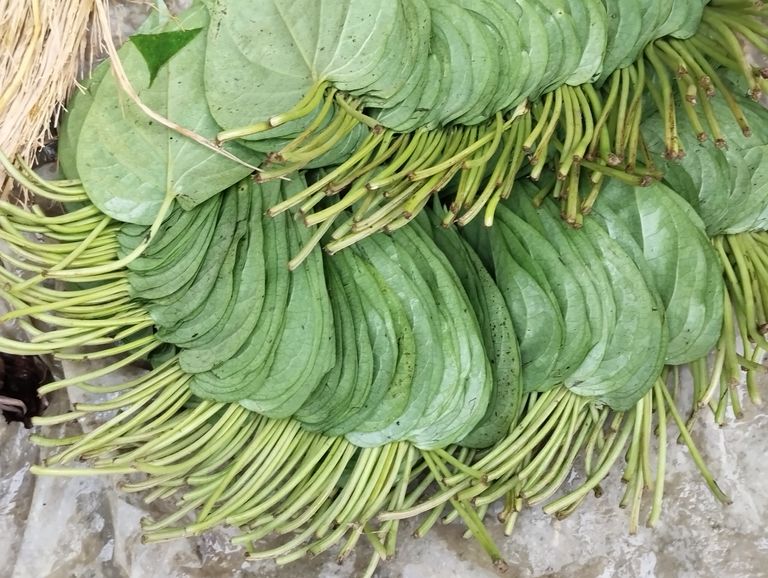Benefits of Chewing Betel Leaves: A Comprehensive Overview.

Introduction
Betel leaf, often associated with traditional customs and rituals in South Asia and Southeast Asia, has been consumed for centuries, especially in countries like India, Bangladesh, Thailand, and Myanmar. Chewing betel leaves, typically with areca nut and slaked lime, is a habit that many indulge in for social, cultural, and medicinal purposes. Although this practice is somewhat controversial due to the potential risks associated with areca nut and tobacco, betel leaves themselves hold numerous health benefits. In this blog, we will explore the various potential benefits of chewing betel leaves, both in traditional and modern contexts.
1. Antioxidant Properties
Betel leaves are packed with antioxidants that help neutralize free radicals, reducing oxidative stress in the body. Free radicals are unstable molecules that can cause cell damage, contributing to aging and various diseases like cancer and heart disease. Chewing betel leaves may, therefore, help in protecting the body from these harmful effects by enhancing the body’s natural defense system.
2. Aids in Digestion
One of the primary reasons people chew betel leaves after meals is to promote digestion. The compounds present in betel leaves stimulate the production of digestive enzymes, helping in the breakdown of food and improving overall gut health. The leaves are also known to have carminative properties, which help in preventing gas formation and bloating, ensuring smooth digestion.
Moreover, betel leaves have been traditionally used to relieve symptoms of constipation, indigestion, and heartburn. It is believed that chewing these leaves increases the secretion of saliva, which contains enzymes that aid in the digestion process.
3. Oral Hygiene and Health
Chewing betel leaves can promote oral hygiene by combating bad breath and protecting against oral infections. The antimicrobial properties of betel leaves help eliminate bacteria in the mouth, preventing the formation of plaque and reducing the risk of cavities and gum diseases. In traditional practices, the betel leaf was also used to treat mouth ulcers and other oral issues, making it a natural remedy for maintaining oral health.
Additionally, chewing betel leaves can stimulate the production of saliva, which naturally cleanses the mouth by washing away food particles and bacteria, further enhancing oral hygiene.
4. Anti-Diabetic Properties
Several studies have shown that betel leaves possess anti-diabetic properties. The leaves help regulate blood sugar levels by promoting insulin activity, making it beneficial for individuals suffering from type 2 diabetes. Regular consumption of betel leaves, under the guidance of a healthcare professional, can be an effective way to manage blood sugar levels naturally.
5. Anti-Inflammatory Effects
Betel leaves contain compounds like phenols and flavonoids that have anti-inflammatory properties. These compounds can help reduce inflammation in the body, which is the root cause of many chronic conditions such as arthritis, cardiovascular diseases, and even certain types of cancer. By reducing inflammation, betel leaves can promote overall health and wellbeing.
6. Boosts Respiratory Health
Betel leaves have long been used as a remedy for respiratory issues. Their expectorant and decongestant properties help in clearing mucus from the respiratory tract, making them beneficial for people suffering from colds, coughs, asthma, and bronchitis. Chewing betel leaves or consuming their juice can provide relief from these conditions by opening up the airways and promoting easier breathing.
Additionally, betel leaves are believed to have a soothing effect on the throat, which can alleviate symptoms of a sore throat or a persistent cough.
7. Relieves Pain and Heals Wounds
Betel leaves are often used in traditional medicine for their analgesic properties. Chewing betel leaves or applying them topically on wounds and insect bites can provide relief from pain and promote faster healing. The anti-inflammatory and antibacterial properties of betel leaves help in reducing swelling and preventing infections, making them a natural remedy for minor injuries.
In rural areas, people often apply a poultice made from betel leaves to wounds or burns to facilitate healing and minimize scarring.
8. Stress Relief and Mood Enhancement
Chewing betel leaves has been known to have mild psychoactive effects, helping to reduce stress and anxiety. The leaves contain compounds that stimulate the release of endorphins, the body's natural "feel-good" hormones, which can elevate mood and create a sense of well-being. This is one of the reasons why betel leaf chewing has been a social activity in many cultures, as it helps in relaxation and improves social bonding.
However, it’s important to note that excessive consumption of betel leaves mixed with tobacco or areca nut may have adverse effects on mental health, potentially leading to dependence or other psychological issues.
9. Helps in Weight Loss
Betel leaves are believed to aid in weight loss by improving digestion and increasing metabolic rate. The active ingredients in the leaves help in breaking down body fat and promoting the utilization of stored fat for energy. Moreover, chewing betel leaves reduces hunger pangs and cravings, making it easier for individuals to manage their calorie intake.
For those looking to lose weight naturally, betel leaves can be a useful addition to a balanced diet and healthy lifestyle. However, moderation is key, and one should avoid combining betel leaves with harmful additives like areca nut and tobacco.
10. Rich in Nutrients
Betel leaves are a good source of vitamins and minerals, including calcium, potassium, iron, and vitamins A and C. These nutrients are essential for maintaining healthy bones, teeth, and overall bodily functions. Chewing betel leaves can help supplement the body’s nutrient intake, particularly in areas where access to diverse foods may be limited.
Precautions and Risks
While betel leaves themselves offer numerous health benefits, the traditional practice of chewing betel leaves with areca nut and tobacco can pose significant health risks. Areca nut has been classified as a carcinogen by the World Health Organization, and its prolonged use is linked to oral cancer and other health issues. Therefore, it’s important to consume betel leaves in their pure form, without harmful additives, to fully reap their health benefits.
Moreover, excessive consumption of betel leaves may lead to unwanted side effects like increased acidity or damage to the teeth and gums. Consulting with a healthcare provider before incorporating betel leaves into your diet or lifestyle is always recommended, especially for individuals with pre-existing health conditions.
Conclusion
Betel leaves, when consumed responsibly and without harmful additives, offer a range of health benefits, from improving digestion and oral health to boosting respiratory function and reducing inflammation. These leaves have been used in traditional medicine for centuries, and modern research is beginning to validate many of these claims. However, it’s crucial to be aware of the potential risks associated with areca nut and tobacco, which are commonly chewed alongside betel leaves.
For those looking for natural remedies and health-boosting habits, betel leaves can be a valuable addition to one’s routine, but always with caution and moderation.


The Harmful Effects of Chewing Betel Leaf (Paan)
Betel leaf, commonly known as "Paan," is a widely consumed substance in many parts of South and Southeast Asia, particularly in countries like India, Bangladesh, Pakistan, and Sri Lanka. It is often chewed with areca nut (supari), slaked lime, and sometimes tobacco or other flavorings. While it has been deeply embedded in cultural and social practices for centuries, its consumption poses significant health risks, especially when combined with harmful substances like tobacco. This blog explores the harmful effects of chewing paan and the long-term health risks associated with its use.
1. Oral Cancer
One of the most severe consequences of chewing betel leaf, especially when mixed with tobacco, is oral cancer. According to numerous studies, the areca nut in paan has carcinogenic properties. The habit of chewing paan exposes the mouth’s soft tissues to these carcinogens for prolonged periods, increasing the risk of developing mouth, throat, and esophageal cancer. The risk is particularly high for those who chew paan with tobacco, as the combination of nicotine and areca nut significantly enhances the cancer-causing potential.
- Oral Submucous Fibrosis (OSMF): Another pre-cancerous condition linked to paan chewing is oral submucous fibrosis. This condition causes stiffening of the mouth’s soft tissues, making it difficult to open the mouth, eat, or even speak. OSMF is irreversible and is a major risk factor for developing oral cancer.
2. Addiction
Chewing paan, particularly with tobacco, can lead to addiction due to the presence of nicotine in tobacco and alkaloids in the areca nut. Nicotine is a potent addictive substance, and over time, users may find themselves unable to stop chewing paan without experiencing withdrawal symptoms such as irritability, restlessness, and cravings. Even paan without tobacco can cause addiction because of the psychoactive compounds present in areca nut, leading to a habit that becomes difficult to break.
3. Teeth and Gum Damage
The habit of chewing paan can cause significant damage to a person’s teeth and gums. The areca nut and other ingredients in paan are highly abrasive and can wear down tooth enamel, leading to increased sensitivity, cavities, and tooth decay. Furthermore, the mixture of lime and areca nut can lead to gum irritation and inflammation, contributing to conditions such as periodontal disease (gum disease), which can cause tooth loss if left untreated.
- Staining of Teeth: Another common issue among paan users is the discoloration and staining of teeth. The pigments in the areca nut and other ingredients cause deep staining, turning the teeth an unsightly brown or red over time. This staining is difficult to remove with regular brushing and often requires professional dental cleaning.
4. Digestive Problems
Chewing paan can also have detrimental effects on the digestive system. Excessive consumption of areca nut stimulates the production of saliva, which may initially seem harmless, but swallowing large amounts of saliva laced with paan ingredients can cause irritation of the esophagus and stomach lining. Over time, this can lead to digestive issues such as:
- Gastritis: The irritants in paan can inflame the stomach lining, causing symptoms like indigestion, bloating, and pain.
- Acid Reflux: Frequent paan chewing may increase the likelihood of acid reflux, where stomach acid flows back into the esophagus, leading to heartburn and discomfort.
- Constipation: Areca nut can have an astringent effect, which may lead to constipation when consumed regularly.
5. Heart Disease and Hypertension
There is a growing body of evidence that suggests regular paan consumption, especially when mixed with tobacco, may increase the risk of cardiovascular diseases. The nicotine and other alkaloids in areca nut can lead to elevated heart rate and blood pressure, putting strain on the cardiovascular system. Over time, this increased strain can lead to:
- Hypertension: The stimulatory effects of nicotine and areca nut raise blood pressure, contributing to chronic hypertension, which is a significant risk factor for heart disease and stroke.
- Increased Risk of Stroke: Prolonged high blood pressure damages blood vessels, making them more prone to rupturing or becoming blocked, which increases the likelihood of a stroke.
6. Social and Environmental Consequences
Beyond the health impacts, paan chewing has various social and environmental consequences. Public spitting of paan, a common practice among chewers, can lead to unsanitary conditions in public places. Paan stains on walls, streets, and public spaces are not only unsightly but also pose health risks by contributing to the spread of diseases.
Additionally, the excessive use of paan contributes to a littering problem, with wrappers and remnants being carelessly discarded in public areas. This littering not only damages the environment but also creates additional strain on waste management systems in urban areas.
7. Economic Burden
The health problems associated with paan chewing can also place a significant financial burden on individuals and healthcare systems. Treatment for diseases such as oral cancer, gum disease, and digestive disorders can be expensive and long-term, often requiring surgery, chemotherapy, or long-term medication. For those from lower-income backgrounds, the costs of medical treatment can lead to financial instability or inability to afford care, further exacerbating health inequalities.
Additionally, the economic impact of lost productivity due to paan-related illnesses should not be underestimated. Individuals suffering from paan-related health issues may face decreased work capacity or early retirement due to illness, which can negatively affect their livelihoods and the broader economy.
8. Impact on Appearance and Social Life
Regular paan consumption can also have negative effects on personal appearance and social life. The staining of teeth and persistent bad breath caused by paan chewing can lead to social embarrassment or avoidance. The physical consequences, such as tooth decay and oral diseases, can make it difficult to eat or speak properly, leading to a diminished quality of life.
Moreover, addiction to paan often leads to frequent use, which can interfere with daily routines, social interactions, and personal responsibilities. The persistent craving for paan, especially in social situations, can lead to a cycle of dependency that is difficult to break.
Conclusion
While betel leaf chewing, or paan consumption, is a cultural practice deeply rooted in the traditions of many regions, its harmful effects cannot be ignored. From life-threatening diseases like oral cancer to more common issues like gum disease, tooth decay, and addiction, the consequences of paan chewing are numerous and severe. Public awareness campaigns and educational efforts are necessary to inform people about the risks associated with paan chewing, particularly when it includes tobacco. Reducing paan consumption could significantly improve public health outcomes and reduce the burden on healthcare systems in countries where paan is commonly consumed.
It is crucial for individuals to be aware of these risks and make informed decisions about their health, potentially seeking alternatives or support to quit the habit before the long-term consequences become irreversible.


Betel Leaf Farming: A Comprehensive Guide
Betel leaf farming, also known as paan cultivation, is a traditional agricultural practice in South and Southeast Asia. Betel leaves, commonly referred to as paan in India and Bangladesh, are chewed with areca nut and slaked lime, and are often wrapped into a parcel known as a betel quid. The leaves are also widely used in religious and cultural ceremonies. Betel leaf farming is highly profitable, yet it requires meticulous care and attention to yield a high-quality product. In this blog, we will explore the essential aspects of betel leaf farming, including the climate requirements, soil preparation, planting techniques, irrigation, pest management, and harvesting.
1. Understanding Betel Leaf (Paan)
The betel leaf comes from the plant Piper betle, which is a member of the pepper family (Piperaceae). It is a perennial vine, which means it can grow continuously throughout the year, provided the environmental conditions are suitable. The leaves are shiny, heart-shaped, and highly aromatic. There are several varieties of betel leaves, each with different taste profiles and textures, but the two most popular varieties are the Bangla and Meetha (sweet) varieties.
2. Climatic Requirements for Betel Leaf Farming
Betel leaf farming thrives in warm and humid tropical and subtropical regions. The ideal temperature range for its cultivation is between 10°C to 40°C (50°F to 104°F). It requires consistent rainfall or irrigation and cannot tolerate frost or extreme temperatures. High humidity (around 40-80%) is essential for the healthy growth of the vine. The best regions for growing betel leaves are areas with mild winters and hot summers, such as certain parts of India, Bangladesh, Thailand, Sri Lanka, and Indonesia.
Betel leaf plants require semi-shaded conditions and cannot survive in full sunlight. Farmers typically grow betel leaves under a trellis system or provide natural shade using trees or artificial shading nets.
3. Soil Requirements and Preparation
Betel leaf plants thrive in well-drained, fertile soil rich in organic matter. Sandy loam or clay loam soils with good water-holding capacity are ideal for betel leaf farming. The soil should be slightly acidic to neutral (pH level of 5.5 to 7.5). Before planting, it is essential to test the soil for its nutrient content and adjust its pH levels if necessary.
Soil Preparation:
- Land Clearing: Remove any weeds, stones, or other debris from the land.
- Tilling: The soil should be plowed and tilled deeply (about 20 to 30 cm) to improve aeration and loosen the topsoil.
- Organic Matter: Incorporate organic manure or well-decomposed compost into the soil to increase fertility. Farmyard manure (FYM), vermicompost, or green manure can be added during soil preparation.
- Drainage: Ensure that the field has proper drainage to prevent water stagnation, which can lead to root rot.
4. Propagation and Planting Techniques
Betel leaf plants are typically propagated through cuttings rather than seeds. Farmers select healthy, disease-free mother vines to obtain cuttings for propagation.
Steps in Planting:
- Selection of Cuttings: Choose mature, healthy vines that are at least 6 to 8 months old. The cuttings should be about 30 to 45 cm in length and have 3 to 4 nodes.
- Rooting: Before planting the cuttings, dip them in a rooting hormone solution to promote root development. This helps speed up the growth process.
- Planting Method: Dig small pits in the soil and plant the cuttings at an angle, leaving about 1 or 2 nodes above the ground. The spacing between each plant should be about 50 cm.
- Support System: Betel leaves are climbers, so they need support to grow. Farmers usually install bamboo stakes or other support systems (known as boroj) to help the vines grow vertically.
5. Irrigation and Watering Practices
Betel leaf plants require consistent moisture, and proper irrigation is crucial for their growth. However, waterlogging should be avoided, as it can cause root diseases.
Irrigation Tips:
- Regular Watering: During dry periods, water the plants every 2 to 3 days to maintain soil moisture.
- Drip Irrigation: If possible, adopt drip irrigation, which provides a consistent water supply and helps conserve water.
- Avoid Waterlogging: Ensure proper drainage in the field to prevent waterlogging, which can damage the roots and lead to fungal infections.
6. Pest and Disease Management
Betel leaf farming is susceptible to various pests and diseases, which can significantly affect yield and quality. The most common issues are fungal infections, leaf spot diseases, and aphid infestations.
Common Pests and Diseases:
- Aphids and Mites: These sap-sucking insects can damage the leaves by causing yellowing and curling. Use neem oil or insecticidal soap to control aphid populations.
- Leaf Spot: Fungal infections like Phytophthora and Colletotrichum cause brown or black spots on the leaves. Use fungicides or organic sprays like copper-based compounds to control these diseases.
- Root Rot: This is caused by waterlogged conditions and poor drainage. Ensure proper irrigation practices to avoid this problem.
Organic Pest Management:
- Neem Oil: Neem oil is effective against a range of pests, including aphids, mites, and caterpillars.
- Companion Planting: Planting herbs like marigold or garlic near betel leaf plants can repel harmful insects.
7. Fertilization and Nutrient Management
Betel leaf plants require regular fertilization to maintain healthy growth. Organic fertilizers are highly recommended, as they improve soil health and boost plant growth without harming the environment.
Fertilization Tips:
- Organic Fertilizers: Use farmyard manure, compost, or vermicompost during soil preparation and as a top dressing every few months.
- Chemical Fertilizers: Apply balanced doses of nitrogen, phosphorus, and potassium (NPK) based on soil testing recommendations. Generally, 60-80 kg of nitrogen, 30-40 kg of phosphorus, and 60-80 kg of potassium per hectare are used for optimal growth.
- Foliar Sprays: Foliar feeding with micronutrients like zinc and iron helps improve leaf quality.
8. Harvesting Betel Leaves
Betel leaves can be harvested after 8 to 12 months of planting, depending on the variety and growing conditions. The best time to harvest is in the early morning when the leaves are fresh and turgid.
Harvesting Techniques:
- Handpicking: Carefully pluck mature leaves by hand to avoid damaging the vine. Mature leaves are shiny, smooth, and fully grown. They are usually harvested every 15 to 30 days.
- Post-Harvest Handling: After harvesting, the leaves should be sorted, cleaned, and bundled. Store them in a cool, humid place to maintain freshness.
9. Economic Importance and Market Potential
Betel leaf farming has significant economic potential due to its high demand in domestic and international markets. It is a lucrative business, especially in regions where paan is consumed regularly. The leaves are sold fresh, and their market price varies depending on the quality, size, and variety. In India, for example, the price of betel leaves can range from ₹100 to ₹300 per 100 leaves.
Moreover, betel leaves have medicinal properties and are used in Ayurveda for treating digestive issues, oral health, and respiratory problems. This adds to their market value and appeal in herbal medicine industries.
10. Challenges in Betel Leaf Farming
While betel leaf farming is highly profitable, it is not without its challenges. Farmers must address issues such as pest infestations, diseases, and market fluctuations. Additionally, labor-intensive practices like harvesting and maintaining the trellis system can increase production costs.
Key Challenges:
- Labor: Betel leaf farming is labor-intensive, requiring constant attention to irrigation, pest management, and harvesting.
- Climate Risks: Erratic weather patterns, droughts, and floods can severely impact yield.
- Market Fluctuations: Prices for betel leaves can vary based on demand, regional production, and export markets.
11. Conclusion
Betel leaf farming is a traditional yet profitable venture for farmers in tropical and subtropical regions. With proper care, suitable climatic conditions, and effective pest management, it can generate significant income. The growing demand for betel leaves, both for consumption and medicinal purposes, ensures a stable market for this crop. Farmers looking to diversify their agricultural portfolio can consider betel leaf cultivation as a viable option, provided they are willing to invest time and labor in its maintenance.
Telegram and Whatsapp